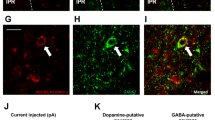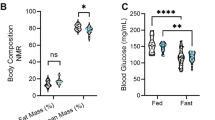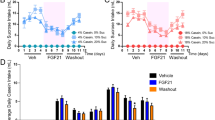Abstract
Umami refers to the savoury taste that is mediated by monosodium glutamate (MSG) and enhanced by inosine monophosphate and other nucleotides. Umami foods have been suggested to increase the risk for obesity and metabolic syndrome but the mechanism is not understood. Here we show that MSG induces obesity, hypothalamic inflammation and central leptin resistance in male mice through the induction of AMP deaminase 2 and purine degradation. Mice lacking AMP deaminase 2 in both hepatocytes and neurons are protected from MSG-induced metabolic syndrome. This protection can be overcome by supplementation with inosine monophosphate, most probably owing to its degradation to uric acid as the effect can be blocked with allopurinol. Thus, umami foods induce obesity and metabolic syndrome by engaging the same purine nucleotide degradation pathway that is also activated by fructose and salt consumption. We suggest that the three tastes—sweet, salt and umami—developed to encourage food intake to facilitate energy storage and survival but drive obesity and diabetes in the setting of excess intake through similar mechanisms.
This is a preview of subscription content, access via your institution
Access options
Access Nature and 54 other Nature Portfolio journals
Get Nature+, our best-value online-access subscription
$29.99 / 30 days
cancel any time
Subscribe to this journal
Receive 12 digital issues and online access to articles
$119.00 per year
only $9.92 per issue
Buy this article
- Purchase on Springer Link
- Instant access to full article PDF
Prices may be subject to local taxes which are calculated during checkout








Similar content being viewed by others
Data availability
Requests for resources, newly generated mouse lines and reagents should be directed to and will be fulfilled by the lead contact, M.A.L. Figures 1–7 and Extended Data Figs. 1–6 represent in their majority the raw data from all individual points. The data that support the findings of this study are available from the corresponding author on reasonable request. This study did not generate unique datasets or code. Raw individual datasets for each study and figures will be available on reasonable request. Source data are provided with this paper.
References
Beauchamp, G. K. & Mennella, J. A. Flavor perception in human infants: development and functional significance. Digestion 83, 1–6 (2011).
Stanhope, K. L. et al. Consumption of fructose and high fructose corn syrup increase postprandial triglycerides, LDL-cholesterol, and apolipoprotein-B in young men and women. J. Clin. Endocrinol. Metab. 96, E1596–E1605 (2011).
Stanhope, K. L. et al. Consuming fructose-sweetened, not glucose-sweetened, beverages increases visceral adiposity and lipids and decreases insulin sensitivity in overweight/obese humans. J. Clin. Invest. 119, 1322–1334 (2009).
Ishimoto, T. et al. Opposing effects of fructokinase C and A isoforms on fructose-induced metabolic syndrome in mice. Proc. Natl Acad. Sci. USA 109, 4320–4325 (2012).
Schwarz, J.-M. et al. Effects of dietary fructose restriction on liver fat, de novo lipogenesis, and insulin kinetics in children with obesity. Gastroenterology 153, 743–752 (2017).
Johnson, R. J. et al. Fructose metabolism as a common evolutionary pathway of survival associated with climate change, food shortage and droughts. J. Intern. Med. 287, 252–262 (2020).
Yang, Q. et al. Added sugar intake and cardiovascular diseases mortality among US adults. JAMA Intern. Med. 174, 516–524 (2014).
Hulthén, L. et al. Salt intake in young Swedish men. Public Health Nutr. 13, 601–605 (2010).
Libuda, L., Kersting, M. & Alexy, U. Consumption of dietary salt measured by urinary sodium excretion and its association with body weight status in healthy children and adolescents. Public Health Nutr. 15, 433–441 (2012).
Choi, Y. et al. Dietary sodium and potassium intake in relation to non-alcoholic fatty liver disease. Br. J. Nutr. 116, 1447–1456 (2016).
Lanaspa, M. A. et al. High salt intake causes leptin resistance and obesity in mice by stimulating endogenous fructose production and metabolism. Proc. Natl Acad. Sci. USA 115, 3138–3143 (2018).
Lanaspa, M. A. et al. Counteracting roles of AMP deaminase and AMP kinase in the development of fatty liver. PLoS ONE 7, e48801 (2012).
Lanaspa, M. A. et al. Uric acid induces hepatic steatosis by generation of mitochondrial oxidative stress: potential role in fructose-dependent and -independent fatty liver. J. Biol. Chem. 287, 40732–40744 (2012).
Cicerchi, C. et al. Uric acid-dependent inhibition of AMP kinase induces hepatic glucose production in diabetes and starvation: evolutionary implications of the uricase loss in hominids. FASEB J. 28, 3339–3350 (2014).
Feigelson, M. & Feigelson, P. Relationships between hepatic enzyme induction, glutamate formation, and purine nucleotide biosynthesis in glucocorticoid action. J. Biol. Chem. 241, 5819–5826 (1966).
Zhang, F. et al. Molecular mechanism for the umami taste synergism. Proc. Natl Acad. Sci. USA 105, 20930–20934 (2008).
Johnson, R. J. et al. Umami: the taste that drives purine intake. J. Rheumatol. 40, 1794–1796 (2013).
Minami, S., Sato, M., Shiraiwa, Y. & Iwamoto, K. Molecular characterization of adenosine 5′-monophosphate deaminase—the key enzyme responsible for the umami taste of nori (Porphyra yezoensis Ueda, Rhodophyta). Mar. Biotechnol. (NY) 13, 1140–1147 (2011).
He, K. et al. Consumption of monosodium glutamate in relation to incidence of overweight in Chinese adults: China Health and Nutrition Survey (CHNS). Am. J. Clin. Nutr. 93, 1328–1336 (2011).
Insawang, T. et al. Monosodium glutamate (MSG) intake is associated with the prevalence of metabolic syndrome in a rural Thai population. Nutr. Metab. (Lond.) 9, 50 (2012).
Bunyan, J., Murrell, E. A. & Shah, P. P. The induction of obesity in rodents by means of monosodium glutamate. Br. J. Nutr. 35, 25–39 (1976).
Collison, K. S. et al. Effect of dietary monosodium glutamate on HFCS-induced hepatic steatosis: expression profiles in the liver and visceral fat. Obesity (Silver Spring) 18, 1122–1134 (2010).
López-Miranda, V. et al. Effects of chronic dietary exposure to monosodium glutamate on feeding behavior, adiposity, gastrointestinal motility, and cardiovascular function in healthy adult rats. Neurogastroenterol. Motil. 27, 1559–1570 (2015).
Nakamura, H., Kawamata, Y., Kuwahara, T., Smriga, M. & Sakai, R. Long-term ingestion of monosodium L-glutamate did not induce obesity, dyslipidemia or insulin resistance: a two-generation study in mice. J. Nutr. Sci. Vitaminol. (Tokyo) 59, 129–135 (2013).
Andres-Hernando, A. et al. Deletion of fructokinase in the liver or in the intestine reveals differential effects on sugar-induced metabolic dysfunction. Cell Metab. 32, 117–127.e3 (2020).
Murata, Y., Beauchamp, G. K. & Bachmanov, A. A. Taste perception of monosodium glutamate and inosine monophosphate by 129P3/J and C57BL/6ByJ mice. Physiol. Behav. 98, 481–488 (2009).
Schiffman, S. S., Sattely-Miller, E. A., Zimmerman, I. A., Graham, B. G. & Erickson, R. P. Taste perception of monosodium glutamate (MSG) in foods in young and elderly subjects. Physiol. Behav. 56, 265–275 (1994).
Shapiro, A. et al. Fructose-induced leptin resistance exacerbates weight gain in response to subsequent high-fat feeding. Am. J. Physiol. Regul. Integr. Comp. Physiol. 295, R1370–R1375 (2008).
Sautin, Y. Y., Nakagawa, T., Zharikov, S. & Johnson, R. J. Adverse effects of the classic antioxidant uric acid in adipocytes: NADPH oxidase-mediated oxidative/nitrosative stress. Am. J. Physiol. Cell Physiol. 293, C584–C596 (2007).
Johnson, R. J. et al. Fructose metabolism as a common evolutionary pathway of survival associated with climate change, food shortage and droughts. J. Intern. Med. 287, 252–262 (2020).
Hudoyo, A. W. et al. Role of AMPD2 in impaired glucose tolerance induced by high fructose diet. Mol. Genet. Metab. Rep. 13, 23–29 (2017).
Clifford, A. J., Riumallo, J. A., Youn, V. R. & Scrimshaw, N. S. Effect of oral purines on serum and urinary uric acid of normal, hyperuricemic and gouty humans. J. Nutr. 106, 428–434 (1976).
Lu, W. et al. Uric acid produces an inflammatory response through activation of NF-κB in the hypothalamus: implications for the pathogenesis of metabolic disorders. Sci. Rep. 5, 12144 (2015).
Sanchez-Lozada, L. G. et al. Uric acid activates aldose reductase and the polyol pathway for endogenous fructose and fat production causing development of fatty liver in rats. J. Biol. Chem. 294, 4272–4281 (2019).
Lanaspa, M. A. et al. Uric acid stimulates fructokinase and accelerates fructose metabolism in the development of fatty liver. PLoS ONE 7, e47948 (2012).
National Research Council of the National Academies. Guide for the Care and Use of Laboratory Animals (National Academies Press, 2011).
Lanaspa, M. A. et al. Opposing activity changes in AMP deaminase and AMP-activated protein kinase in the hibernating ground squirrel. PLoS ONE 10, e0123509 (2015).
Lanaspa, M. A. et al. The tight junction protein, MUPP1, is up-regulated by hypertonicity and is important in the osmotic stress response in kidney cells. Proc. Natl Acad. Sci. USA 104, 13672–13677 (2007).
Acknowledgements
We thank E. E. Smith for her contribution to this research and A. Quador and J. Arnold of the University of Colorado Denver Histology Shared Resource. This resource is supported in part by the Cancer Center Support Grant (no. P30CA046934). This work has been supported by NIH grant nos. 1R01DK121496-01A1 (to M.A.L. and R.J.J.) and 1R01DK108859 (to M.A.L.). A.A.H was supported by funding from the Colorado Nutrition Obesity Research Center (no. 25M9260) from parental grant P30DK048520.
Author information
Authors and Affiliations
Contributions
M.A.L. and R.J.J. designed the research. M.A.L., A.A-H., L.G.S-L., T.N. and R.J.J. analysed the data. A.A-H., C.C., D.J.O., M.K. and M.A.L. performed the research. A.A-H., M.A.L. and R.J.J. wrote the paper.
Corresponding author
Ethics declarations
Competing interests
M.A.L. and R.J.J. are inventors in two patents (nos. 13/814,568 and 62/473,005) related to the blockade of fructokinase to treat metabolic syndrome. M.A.L. and R.J.J. are founders and members of Colorado Research Partners, a company dedicated to the generation of fructokinase inhibitors. The other authors declare no competing interests.
Additional information
Peer review information Nature Metabolism thanks the anonymous reviewers for their contribution to the peer review of this work. Christoph Schmitt was the primary handling editor.
Publisher’s note Springer Nature remains neutral with regard to jurisdictional claims in published maps and institutional affiliations.
Extended data
Extended Data Fig. 1 MSG is a more potent inducer of metabolic syndrome than fructose.
A) Mean daily water intake, B) daily food intake and C) total caloric intake in wild type mice on water control or exposed to the same amount of fructose or MSG (300 mM) for 15 weeks. D) Body weight gain in the same groups as in A). E) Representative H&E images of liver and F) epididymal adipose in the same groups as in A). Size bar: 20 µm G) Liver weight, H) intrahepatic triglycerides and I) plasma AST levels in the same groups as in A). J) Epididymal adipose weight and K) crown structure scoring as well as L) fasting plasma levels of insulin and M) leptin in the same groups as in A). Data in A-B and D-M represent individual points with mean ± SEM. Data in C represent mean ± SEM. One Way ANOVA. N = 6 mice per group.
Extended Data Fig. 2 Tamoxifen does not interfere in metabolic syndrome induced by MSG.
A) Representative western blot in liver for AMPD2 (top) and actin loading control (bottom) in tamoxifen-resistant AMPD2Fl/FL mice and tamoxifen-inducible AMPD2 knockout mice (AMPD2Fl/FLxCre-UBC) at days 0, 5 and 12 after tamoxifen treatment. B) Seven hour food intake in AMPD2Fl/FL (black) and AMPD2Fl/FLxCre-UBC (red) mice before (weeks 0 to week 7) and after (week 7 to week 15) tamoxifen (TMX) treatment C) MSG solution drinking in the same groups as in B) D) Body weight gain in in the same groups as in B) E) Fat/fat free mass ratio in in the same groups as in B) F) Fasting plasma insulin in AMPD2Fl/FL (black) and AMPD2Fl/FLxCre-UBC (red) mice at baseline (week 0), before TMX treatment (week 7) and after TMX treatment (week 15). G) Fasting plasma leptin levels in the same groups as in G). H) Leptin sensitivity in AMPD2Fl/FL mice at baseline (week 0), and after TMX treatment (weeks 9 and 15). I) Leptin sensitivity in AMPD2Fl/FLxCre-UBC mice at baseline (week 0), before TMX treatment (weeks 9 and 15). Data in F-G represent individual points with mean ± SEM. Data in B-E represent mean ± SEM. Data in H-I represent the mean. One Way ANOVA (F-G) and 2-tail t-test (A-E and H-I). N = 6 mice per group.
Extended Data Fig. 3 Leptin sensitivity in wild type mice exposed to MSG + IMP for 30 weeks.
A) Seven hour food intake after leptin injection in mice on water control, or exposed to IMP (300 μM), MSG (30 mM) or a MSG + IMP combination for 30 weeks and injected with leptin. B) Hypothalamic uric acid and C) TBAR levels in mice on water control, or exposed to IMP (300 μM), MSG (30 mM) or a MSG + IMP combination for 15 weeks. D) Hypothalamic mRNA levels of the leptin receptor (lepr), and cytokines il6 and tnfa. Data in B-D represent individual points with mean ± SEM. Data in A represent the meanOne Way ANOVA (B-D) and 2-tail t-test (A). N = 6 mice per group.
Extended Data Fig. 4 Downstream products of IMP exacerbate MSG-induced metabolic syndrome.
A) Body weight gain and B) cumulative total caloric intake in wild type mice on water control, or exposed to IMP, inosine, hypoxanthine, uric acid or allantoin (300 μM) for 30 weeks. C) Body weight gain and D) total caloric intake in wild type mice on water control, or exposed to MSG (30 mM) alone or in combination with IMP, inosine, hypoxanthine, uric acid or allantoin (300 μM) for 30 weeks. E) Epididymal adipose weight, F) liver weight, G) representative H&E images of liver, H) intrahepatic triglycerides and I) plasma AST, J) insulin and K) leptin levels in wild type mice of the same groups as in C). Size bar: 20 µm. Data in E-F, H-K represent individual points with mean ± SEM. Data in B and D represent mean ± SEM. Data in A and C represent the meanOne Way ANOVA. N = 6 mice per group.
Extended Data Fig. 5 Allopurinol ameliorates metabolic syndrome induced by MSG + IMP.
A) Plasma and B) intrahepatic uric acid levels in wild type mice on water control, allopurinol (AP, 1.1 mM), MSG (30 mM) alone, or in combination with IMP (300 μM) or IMP + allopurinol (AP, 1.1 mM) for 30 weeks. C) Cumulative total caloric intake and D) body weight gain in the same mice as in A). E) Epididymal adipose weight, F) liver weight, G) representative H&E images of liver, H) intrahepatic triglycerides and I) plasma AST, J) insulin and K) leptin levels in wild type mice of the same groups as in A). Size bar: 20 µm. Data in A-B and D-K represent individual points with mean ± SEM. Data in C represent mean ± SEMOne Way ANOVA (A-C, F, H-J and N-O) and 2-tail t-test (D-E, G, K-M and P-Q). N = 6 mice per group.
Extended Data Fig. 6 MSG and IMP activate astrocytes and microglia in the hypothalamus.
A) Representative western blot and B) densitometry for GFAP (astrocyte marker), Iba1 (microglia marker) and actin loading control in hypothalamus of wild type mice exposed to water, IMP, MSG (30 mM) or MSG + IMP. Data in B-C represent individual points with mean ± SEM. One Way ANOVA. N = 6 mice per group.
Supplementary information
42255_2021_454_MOESM2_ESM.pdf
Supplementary Table 1 General parameters in water control mice or mice exposed to MSG alone or in combination with purines.
Source data
Source Data Fig. 1
Unprocessed western blot for Fig. 1.
Source Data Fig. 2
Unprocessed western blot for Fig. 2.
Source Data Fig. 3
Unprocessed western blot for Fig. 3.
Source Data Fig. 4
Unprocessed western blot for Fig. 4.
Source Data Fig. 5
Unprocessed western blot for Fig. 5.
Source Data Fig. 7
Unprocessed western blot for Fig. 7.
Source Data Extended Data Fig. 2
Unprocessed western blot for Extended Data Fig. 2.
Source Data Extended Data Fig. 6
Unprocessed western blot for Extended Data Fig. 6.
Rights and permissions
About this article
Cite this article
Andres-Hernando, A., Cicerchi, C., Kuwabara, M. et al. Umami-induced obesity and metabolic syndrome is mediated by nucleotide degradation and uric acid generation. Nat Metab 3, 1189–1201 (2021). https://doi.org/10.1038/s42255-021-00454-z
Received:
Accepted:
Published:
Issue Date:
DOI: https://doi.org/10.1038/s42255-021-00454-z
This article is cited by
-
Update in uric acid, hypertension, and cardiovascular diseases
Hypertension Research (2023)
-
Sugar substitutes and taste enhancers need more science, sensitivity- and allergy-guided labeling
npj Science of Food (2023)
-
Umami taste—a novel mechanism driving food intake and obesity
Nature Metabolism (2021)
-
Unravelling umami-induced obesity
Nature Reviews Endocrinology (2021)



